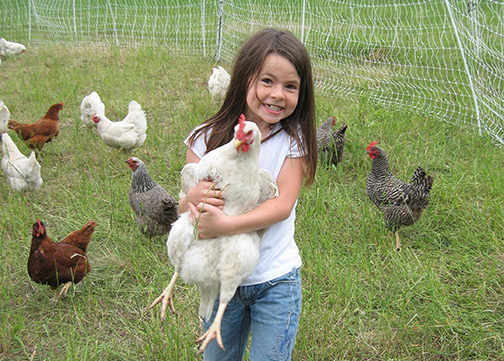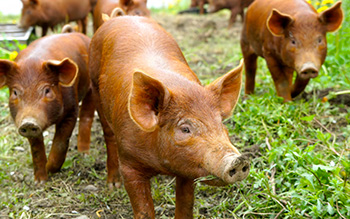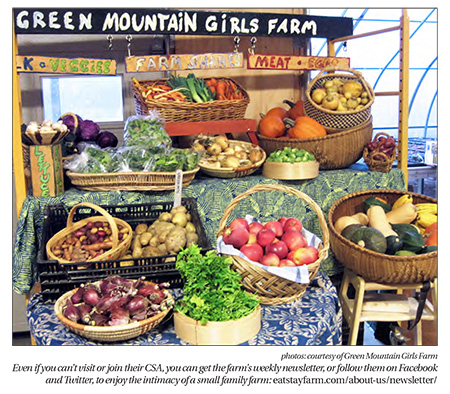| Green Mountain Girls Farm: An Agri-Tourism Success | ||||||||
| by Allison Teague | ||||||||
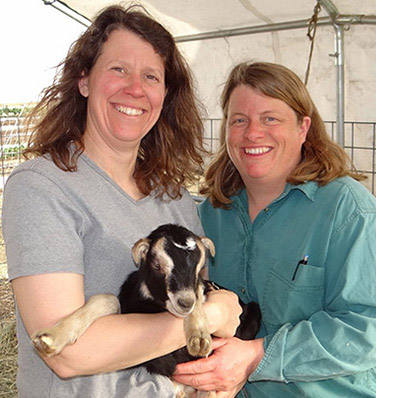
|
Mari Omland and Laura Olsen of Green Mountain Girl Farm would count it significant that Vermont chose Ceres, the Roman goddess of agriculture, to overlook Montpelier’s statehouse and surrounding hills. Ceres holds a shock of grain in her arms.
Since the 1700s, Vermonters have been wresting agricultural livelihoods from hilltops and riverine environments. The first farms were self-sufficient and farming families lived on what they raised. Later, sheep farming changed the landscape to open fields of pasture. And now, a new wave of farmers is investing in restoration of the state’s working lands. Omland and Olsen bought their 40-acre farm in 2007. Nestled atop the hills just south of Paine Mountain in Northfield—and within two miles of I-89, not far from Ceres in Montpelier—the undulating farm and its land is part of 110-acres originally donated to the Vermont Land Trust (VLT) by Thomas and Thelma Osgood in 1993. (See sidebar, How Land Trusts Work). Their farm abuts 313 contiguous acres also protected from real estate development by the land trust, using a legal tool called a conservation easement. In the case of GMGF’s land, the Osgood’s conserved it with the intention that it remain open and part of Vermont’s rural, productive, and natural landscape. Since buying the farm, the two women have developed a delightful experience for visitors and CSA farmshare members alike. Their logo invites others to “Eat. Stay. Farm.” |
|||||||
Tapping into Vermont’s push toward “agri-tourism,” a new way for farmers to increase their income, they combine agriculture, its products and its experience, with tourism. Both Omland and Olsen are helping create wider appreciation for the land and its importance. The name, “Green Mountain Girls Farm” (GMGF) pays homage to the Green Mountain boys, a feisty band of New England revolutionaries who roamed the spiny ridges of Vermont, fighting for an independent way of life. Their difference, co-owner Mari Olsen states: “Ours is more an agronomist’s revolution of farmers meeting in church basements, a food revolution of bringing grains back to Vermont.” While they do not raise grains themselves, the farm is home to grain-eating livestock. They grow vegetables year round. They offer hands-on farm experiences and farm stays, with overnight lodging in the barn guesthouse, or the Farmhouse Inn. They book events, such as weddings, suppers and musical events. Their farm stand for farmshare members offers local, sustainable eggs, meat, vegetables and milk. It’s a unique interface of ongoing farm life for agri-tourists and non-farming community neighbors, now in its fifth year. When Mari Omland and Laura Olsen met and married while living in Washington D.C., they both knew they were interested in farming, Olsen recalled. “We had both long wanted to move back to Vermont,” she said, adding that her environmental studies, grassroots community and garden building in D.C., and Omland's family's “generations” as farmers, brought that reality closer. Together, they honed marketing and fund-raising skills. “We both came from nonprofits and trying to influence people to care for their environment.” Omland had worked with Conservation International in Ghana helping to create a national park, “a bridge to learn about the world and diverse cultures and eco-tourism.” They arrived in Vermont to “community shop,” knowing they were “very interested in something entrepreneurial with food. Whether that was a general store, farm tourism, a Bed & Breakfast—we were open to a few options when we landed here.” When they discovered the farm they now own, “We fell in love with the barn, the location,” said Olsen. They could both see that “’Ag’ and tourism were begging to be done here.” They inherited the land trust that came with it. “Sharing the farm came very naturally for us. It’s what we wanted to do,” Omland said. Conservation had been part of Omland’s background. Combining their mutual love and respect for nature and an “entrepreneurial itch,” the two women’s personalities and experiences bore fruit in an increasingly successful Green Mountain Girls Farm. |
||||||||
|
Like much farmland in Vermont, their land’s vegetation, soil and water needed balance restored. They began to study the land and its environs, talk to neighbors, and create a plan. Omland said that farming is “...a small, tight knit community. It’s not easy to be a small business owner or a farmer.” So they have networked with other local farmers. “Being so close together, we can share resources, meet regularly and support each other.” At both the state and local levels, they talk to supporting professionals, about best practices, ideas, and science. Omland currently sits on the board of the Highfields Center for composting, a flagship program that provides community-based solutions for composting. |
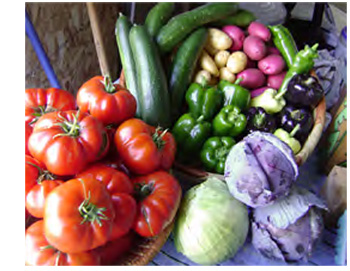 |
|||||||
| GMGF is a member of a local cooperative, similar to a CSA. They offer “free choice” farmshare options to members. Members are from local communities like Montpelier, Barre and Williamstown, as well as Northfield and the neighborhood they live in.
Omland said good quality products were a nonnegotiable part of their plan. “If we had to cut back our standards for quality to be profitable,” Omland said, they didn’t want to go in that direction. “The struggle with profitability is a regular bottom line for people who farm….but it's not the only bottom line.” Only after five years of hard work has the balance of the land and its environs been restored to their standards. Now they can really get down to the work of farming and “agri-tourism.” Partner Olsen explained the different ways locals can access their farm products. GMGF’s “farmshare” is a form of Community Supported Agriculture, a CSA. Different options meet customer's varying needs; “free choice” farmsharing is built on trust. They raise pigs, goats and chickens as well as seasonal crops and some crops, like spinach grown in a greenhouse, year round. By buying in with an “omnivore farmshare,” members have a free choice of products. Once a week on Thursdays, year round, the farm stand in the lower part of the barn is open for members to get what they need. $200 per adult per month, or a $100 dollar commitment with a ten percent discount, assures members access to farm produce and farm stand products. People write down what they leave with. Olsen said, “We've never had anyone take advantage of the free choice and take too much. If anything, we've had to remind a few people to come by and get more.” She said consumption varies with most people, but it “evens out” in the end. Such trust, Omland and Olsen agreed, invests their members in the farm even more.
Overnight guests may stay in the barn guesthouse. It’s a beautifully refurbished large, two floor apartment with huge hand-hewn barn beams, and a fully equipped and stocked kitchen and fridge. But guests do arrive through a working barn entrance, where goats and pigs are often penned, especially during birth season, which was when Vermont Woman visited in March. “Kids love it! They stand there for hours watching the animals,” Omland said. Omland said guests especially enjoy “lattes on the hoof,” frothy milk squeezed straight from the goat's teat into their morning coffee. “The kids and even adults get giddy when they see this,” she smiled. “There is something about the connection of seeing where the milk comes from, seeing the froth in their coffee, and then tasting how good it is.” Omland said, “Whatever slice of the farm you see teaches you about systems. It’s an automatic perspective changer. I hope guests take home a desire to experience farms more in their lives.”
She explained, “Yes, this carrot is more expensive, but by paying more for that carrot, I am enabling young people in my community to have jobs. I enable them to learn to work hard and learn about entrepreneurial retail; you are paying for the labor. But it also means no residuals from plastic, squelching [plant growth somewhere else]. And all of a sudden that carrot looks really worthwhile, because that carrot comes without a footprint of destruction. There are a lot of righteous things coming with this carrot, even though it costs a lot more. It probably tastes a whole lot sweeter, too,” she smiled. Without profitability, farmers cannot continue to farm. The community then loses a valuable resource in fresh, healthy, pesticide-free local food and the healthy soil that grows it, she says. The built-in invisible costs of commercial food shipped in from long distances actually make it more expensive to local communities, in danger of becoming dependent food deserts. Investing in local farmers closes the loop and keeps food, nutrition, jobs for local youth, and small farms a viable resource, Omland argues.
Their goal is sustainable, good nutrition. Because they use heirloom seeds, their vegetables may be smaller and non-uniform. The tomatoes may have one side that is slightly bulging because it got more sun than one on the other side of the plant. “Vegucation,” Omland called it, another one of their goals. She told a story: “Some of our potatoes didn't grow big one year. So we put them all in a basket in the farm stand. That got people thinking about making a different dish with small potatoes.” Olsen added that “sharing” recipes is a huge part of the “socializing” that has become part and parcel of the farm stand, weekly. Vermont carrots are irregular-shaped carrots, she said, but she loved to see how “kids would come in with their parents to pick up their farmshare each week, and while the parents were selecting what they wanted, the kids will choose the misshapen carrot and tell a story about it.” Omland said kids will pick a pepper which “may not be the prettiest pepper, but it’s very, very tasty still. And it’s the most loved pepper around.” She said, “Food grows in and amongst other plants. It’s relevant to understand where it comes from, so there isn't waste, and people eat everything grown.”
Farmshare members arrived while Vermont Woman visited the farm stand on a Thursday in March. One woman explained she had been a vegetarian for 15 years and, since becoming a farmshare member, was consuming meat again. Why? Because she was “seeing how well they treat their animals, how they talk to them, pet them, and name them.” She “just felt more comfortable” eating meat again. And, she said, “It tastes delicious.” Olsen, too, admitted she had been a vegetarian for 22 years prior to starting the farm. Farmshare members said the quality and taste of the grass-fed pork, chicken and goat meats gave them an appreciation of where their food came from, based on seeing and knowing the animals, and how they were raised. Nothing is wasted on the farm. The day of our arrival, Mahjong, one of fifteen, mixed Boer breeding and milk goats (named yearly for games, weather, geography, movie stars and children's stories—so far), had to be euthanized by the vet. “It’s sad, but it’s the cycle of life,” Olsen said. They were in the process of “completing that cycle” when I arrived. They had been singing to the goat, as they prepared it for its burial. In the compost pile. “We talk to all our animals,” they explained; Mahjong was very much a part of the farm family. Olsen said the vet had checked the animal frequently over the past month, and turned up no reason that Mahjong had stopped thriving. That morning, the decision had been made to euthanize her. Omland said the vet performed a necropsy; results showed Mahjong had cancer and “something wrong” with her lungs. Emphasizing that they approach their farming practice systematically, keeping an eye towards efficiency and best practices for the animals and organic farming, “We took the opportunity to really study Mahjong,” as they went through the results to determine if they should change any animal practices. But it seemed it was not a parasite, a virus, or something they could have averted. Sad, but fully appreciative that nothing on the farm is wasted, and that Mahjong would continue to contribute, they buried her beneath layers of wood chips, hay and barn compost, “which will heat up, absorb her and feed the crops.” The same crops that feed them, their other animals, their neighbors, and Farmshare members. The cycle continued as Olsen and Omland sang “Fly Away,” the composting process begun. “Now she's part of the farm,” Omland said as she walked away, a slight catch in her voice.
|
||||||||
| Allison Teague is a regular contributor to Vermont Woman, most often writing about the environment and the arts.
For more information on visiting Green Mountain Girl Farm, visit www.eatstayfarm.com, or call 802-505-9840. Or email: farmers@eatstayfarm.com
|
||||||||
